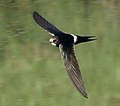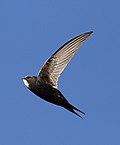| White-rumped swift | |
|---|---|
 | |
 | |
| Scientific classification | |
| Kingdom: | Animalia |
| Phylum: | Chordata |
| Class: | Aves |
| Clade: | Strisores |
| Order: | Apodiformes |
| Family: | Apodidae |
| Genus: | Apus |
| Species: | A. caffer |
| Binomial name | |
| Apus caffer (Lichtenstein, MHC, 1823) | |
The white-rumped swift (Apus caffer) is a species of swift. Although this small bird is superficially similar to a house martin, it is not closely related to that passerine species. The resemblances between the swallows and swifts are due to convergent evolution reflecting similar life styles.






